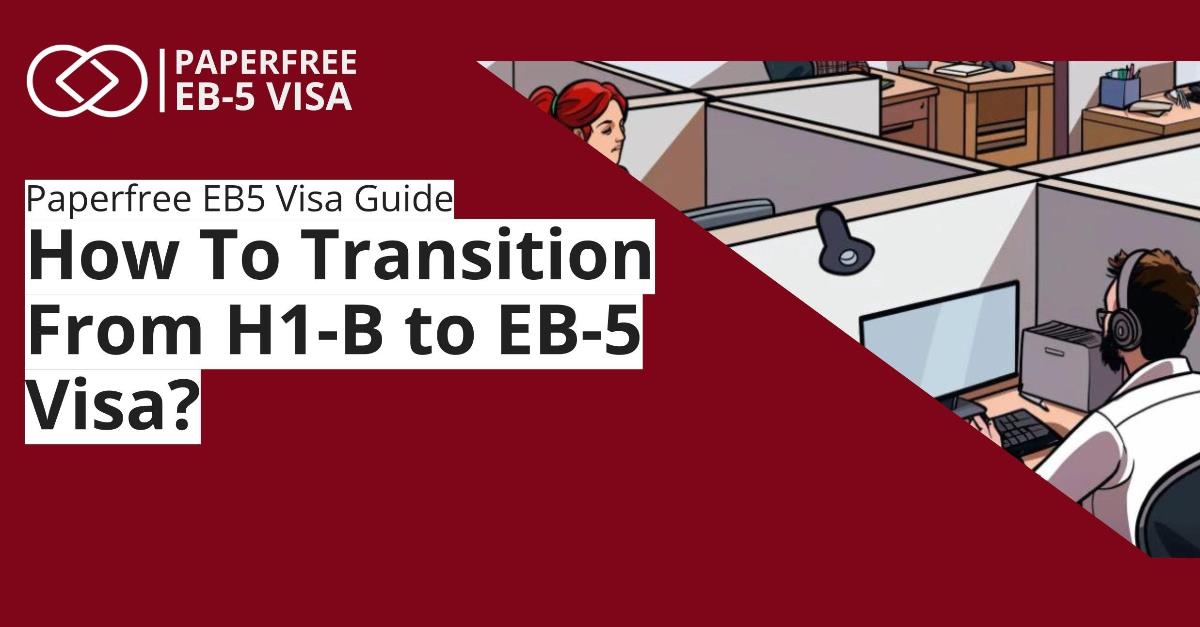H1B to EB5 Transition: How to Change an H-1B Visa to an EB-5 Visa Through Investment Visa Program EB5
Key Steps in the H1B to EB5 Visa Transition: Navigating the EB5 Visa Process While on H1Blast updated Thursday, February 20, 2025
#h1b to eb5 #h1b to eb5 visa
| | John Burson | Subscribe |

QUICK LINKS
AD
Get access to EB 5 Visa Investment Projects
Key Steps in the H1B to EB5 Visa Transition:
- Maintain H1B Status: Continue to fulfill your H1B job requirements and avoid employment gaps while transitioning to EB5.
- Assess Eligibility: Ensure you meet the financial and job creation requirements for the EB5 visa, including having $1.05 million (or $800,000 in TEAs) to invest.
- Choose an Investment Option: Decide between a direct investment (actively managing a business) or investing in a regional center (more passive investment).
- File Form I-526: Submit the Immigrant Petition by Alien Investor, proving your investment meets EB5 criteria and detailing job creation plans.
- Concurrent Filing (Optional): You can file Form I-526 (investment petition) and I-485 (green card application) together to speed up processing.
- Conditional Green Card: Once I-526 is approved, receive a conditional green card for two years. Ensure the investment and job creation requirements are met.
- File Form I-829: After two years, file Form I-829 to remove the conditions and obtain permanent residency.
- Address Requests for Evidence (RFEs): If USCIS issues RFEs, respond promptly with thorough documentation to avoid delays.
The process can take 3-8 years, depending on your circumstances and USCIS workload. Be prepared with legal and financial support throughout.
Are you on an H1B visa and considering securing your future in the U.S.? The EB5 visa process is what you need when on H1B. Many H1B holders are exploring the H1B to EB5 visa route as a viable path to gaining permanent residency in the United States through investment.
This guide will walk you through transitioning from an H1B to an EB5 visa, equipping you with the steps and details to move smoothly from your H1B status to an EB5 and preparing you to overcome potential challenges in your journey to permanent residency through investment. These challenges may include the substantial investment required and the job creation mandate, which we will discuss in detail.
Transitioning from H1B to EB5 requires meticulous planning and a thorough understanding of both visa categories. This careful approach ensures compliance and increases the likelihood of success in your application, providing a sense of reassurance and preparedness.
Explore our Real Estate Investment Strategies and EB5 Investment Projects to make informed decisions about the EB-5 Visa Program process.
What is an H1B Visa?
The H-1B visa is a U.S. visa that allows companies to employ foreign workers in specialty occupations that require technical expertise, such as IT, finance, engineering, and medicine. The visa is typically valid for three years and can be extended up to six years.

H1B Visa: Work and Temporary Residency
Purpose and Benefits:
The H1B visa allows U.S. employers to hire foreign professionals in specialty occupations requiring specific expertise. The main benefit of the H1B visa is that it permits the holder to work in the U.S. for up to six years. H1B visa holders can bring their immediate family members (spouse and children under 21) to the U.S. under the H4 visa category.
H1B visa Eligibility Requirements:
To qualify for an H1B visa, applicants must meet the following H1B visa eligibility requirements:
- Have a job offer from a U.S. employer.
- Hold a bachelor’s degree or equivalent in the relevant field.
- The job must qualify as a specialty occupation requiring specialized knowledge and skills.
Advantages and Disadvantages of H1B Visa
Advantages of H1B Visa
- Provides skilled workers a pathway to valuable employment opportunities in the U.S.
- Access to advanced career prospects and higher earnings compared to home countries.
- Opportunity to gain experience in a global market and work for renowned companies
Disadvantages of H1B Visa
- Dependency on the employer, leading to limited job mobility.
- Potential for lengthy processing times.
- Challenges include the annual cap on visa issuance and job security tied to the employer's financial health.
- Uncertainty of visa renewals.
- H1B consular processing disadvantages include extended wait times and the risk of visa denial.
Understanding EB-5 Visa:
The EB-5 visa is a U.S. visa for immigrant investors who can become permanent residents by investing $1,050,000 (or $800,000 in a targeted area) in a new business that creates at least ten full-time jobs for American workers.

EB5 Visa: Investment and Permanent Residency
Purpose and Benefits of EB5 Visa:
The EB5 visa, designed to stimulate the U.S. economy through capital investment by foreign investors, offers a promising path to permanent residency (green card) for the investor, their spouse, and their unmarried children under 21. This visa allows investors to live and work in America, offering greater flexibility and security than temporary work visas. It instills a sense of hope and optimism in your transition journey, knowing that you are investing in your future in the U.S.
Eligibility Requirements:
To be eligible for an EB5 visa, applicants must:
- Invest a minimum of $1.05 million in a new commercial enterprise, or $800,000 if the investment is in a Targeted Employment Area (TEA), which includes rural areas or areas with high unemployment.
- The investment must create or preserve at least ten full-time jobs for qualifying U.S. workers within two years. This job creation mandate is essential to the EB5 visa program, and understanding it is crucial for a successful transition.
What are the Differences Between H1B and EB-5 Visas?
Understanding the differences between the EB5 H1B visas can help potential immigrants choose the right path for their needs. The H1B EB5 visas serve different purposes; the former is for skilled workers, while the latter is for investors.
This table shows the critical differences between H1B and EB-5 Visa programs:
|
Feature |
H-1B Visa |
EB-5 Visa |
|
Work |
Limited to specific jobs & employer |
Work anywhere in the US; no sponsorship is needed |
|
Politics |
It may be seen as a threat to the US workforce |
It creates jobs & boosts the US economy |
|
Visa Requirements |
|
|
|
Family |
The spouse can work with an H-4 visa (limited conditions) |
Spouse & unmarried children (<21) get green cards |
|
Annual Quotas |
85,000 visas |
700 visas per country |
|
Permanence |
Temporary, needs renewal |
Permanent residency (green card) path to citizenship |
|
Transition |
N/A |
Offers a path to a Green Card |
Make informed EB-5 decisions. Eb5 Processing times and Eb5 Visa eligibility explained by Paperfree.com
Work Authorization vs. Investment Requirement
Nature of Each Visa Type:
The H1B visa is for professionals in specialized fields and requires a U.S. employer to sponsor them. It allows you to work for a specific employer in the U.S. On the other hand, the EB5 visa is aimed at investors who inject significant funds into U.S. businesses, creating jobs. Unlike the H1B, this visa doesn’t require a job offer but a substantial financial investment.
Temporary vs. Permanent Residency
Duration and Stability:
The H1B visa grants temporary residency for up to six years, with an initial three-year period that can be extended for another three years. Your stay is tied to your employment. In contrast, the EB5 visa leads to permanent residency. Initially, you get a conditional green card for two years, which becomes permanent once you meet investment and job creation requirements. This makes the EB5 a more secure, long-term option, providing reassurance and confidence in your transition.
Application Processes and Timelines
Steps Involved in Each Process:
Applying for an H1B visa involves your employer filing a Labor Condition Application (LCA) and Form I-129 with the USCIS. After approval, you apply for the visa at a U.S. consulate, which can take several months. For the EB5 visa, you start by filing Form I-526 to prove your investment meets the requirements. After approval, you apply for a conditional green card using Form I-485 (if you're in the U.S.) or DS-260 (abroad). To remove conditions and get a permanent green card, you file Form I-829 within 90 days before your second anniversary. The EB5 process can take several years due to job creation and other requirements.
The Transition Process: H1B to EB5 Green Card
Many H1B visa holders ask, "Can I apply for EB 5 while on H1B?" The answer is yes, but specific conditions must be met. Transitioning from an H1 B to EB5 green card can be a strategic move for those seeking permanent residency through investment. Remember the H1B visa disadvantages; common H1B visa problems include long processing times, strict employment conditions, and limited renewal options.
Initial Steps and Considerations
Assessing Eligibility:
Assessing your eligibility is essential before starting the transition from H1B to EB5. This involves understanding the EB5 visa requirements, such as having the necessary investment capital and ensuring your funds are legally sourced. Evaluating whether your professional and financial circumstances align with the EB5 program's job creation and economic growth goals is crucial. Not meeting these requirements could delay your EB5 visa application, so a thorough eligibility assessment is vital.
Financial Planning for Investment:
Financial planning is a critical step in the transition process. You must ensure you have the minimum required investment of $1.05 million or $800,000 for Targeted Employment Areas (TEA). It's important to consider all costs associated with the EB5 process, including:
- Legal Fees: Hiring an experienced immigration attorney can help navigate the complexities of the EB5 process.
- Administrative Fees include filing fees and other costs related to the application.
- Maintenance of H1B Status: Be aware of any potential expenses related to maintaining your H1B status during the transition.
Effective financial planning ensures you are prepared for all aspects of the EB5 process, reducing the risk of financial setbacks or delays. It gives you a sense of control and preparedness in your transition journey.
Choosing the Right Investment
Types of Qualifying Investments:
Choosing a suitable investment is pivotal for the EB5 visa. Investments can be made in new commercial enterprises or regional center projects. It’s essential to understand the differences and benefits of each type. New commercial enterprises require direct management, while regional center projects allow for indirect job creation and less day-to-day involvement.
Direct vs. Regional Center Investments
- Direct Investments involve directly managing a business that creates at least ten full-time jobs. This option requires a hands-on approach and is suitable for those who want to be actively engaged in their business.
- Regional Center Investments: These are managed by third parties and focus on indirect job creation. This option is less hands-on and ideal for those who prefer a more passive investment role. Regional centers are pre-approved by USCIS, which could streamline the application process.
Filing Form I-526
Detailed Steps and Documentation Required:
Filing Form I-526, Immigrant Petition by Alien Investor, is the first formal step in the EB5 process. This form demonstrates that your investment meets the program’s requirements. Essential documentation includes proof of the investment amount, evidence of the legal source of funds, and a comprehensive business plan detailing job creation.
Legal Assistance and Advice:
Given the complexity of the EB5 visa process, legal assistance is highly recommended. An experienced immigration attorney can guide you through the paperwork, ensure all documentation is in order, and help you navigate legal hurdles. They can also provide valuable advice on selecting the best investment options and maintaining compliance with USCIS requirements.
Detailed EB5 Visa Process When on H1B
Transitioning from an H-1B visa to an EB-5 Green Card offers a path to permanent residency. However, navigating the process requires careful planning and adherence to specific guidelines.
Let's break down the key steps involved:
Step 1. Maintaining H-1B Status During EB-5 Application:
- Remain compliant with your current H-1B visa.
- Continue fulfilling your job duties as outlined in your H-1B petition.
- Maintain your employment relationship with your H-1B sponsor and avoid employment gaps.
- Meticulously document everything and keep USCIS updated on any changes in your employment status.
Step 2. Concurrent Filing of I-526 and I-485 (Optional):
This strategy allows you to apply for an adjustment of status to a Green Card while your EB-5 petition (Form I-526, Immigrant Petition by Alien Investor) is pending.
Benefits:
- Faster processing times.
- Remain in the U.S. without needing to leave and re-enter.
Risks:
Complications if your I-526 petition is denied, potentially impacting your ability to stay in the US.
Step 3. Conditional Permanent Residency and Removal of Conditions:
a) Steps After Obtaining Conditional Residency:
- You'll receive a conditional Green Card upon initial approval.
- You must fulfill the investment and job creation requirements outlined in the EB-5 program within the two-year conditional period.
- Ensure your investment remains active and the business plan is on track to create the required jobs.
b) Filing Form I-829:
- Within 90 days before the second anniversary of receiving your conditional Green Card, file Form I-829 (Petition by Entrepreneur to Remove Conditions on Permanent Resident Status).
- This form provides evidence that you have met all EB-5 program requirements.
- Once approved, the conditions on your Green Card will be removed, granting you permanent residency in the U.S.
By following these steps and consulting with an expert EB-5 Visa consultant, you can navigate the EB-5 visa process while maintaining your H-1B status and ultimately achieving permanent residency in the United States.
Financial Requirements and Investment Options Needed to Transition from H1B to EB5
Minimum Investment Amounts
TEA vs. Non-TEA Investments:
The minimum investment amount for an EB5 visa is $1.05 million. However, if your investment is in a Targeted Employment Area (TEA), which includes rural areas or areas with high unemployment, the required amount is reduced to $800,000. TEAs offer a lower financial barrier but still require robust job creation plans.
Types of Investments
- Real Estate: Investing in commercial real estate projects can qualify if they meet job creation requirements.
- Businesses: Direct investments in new commercial enterprises where the investor plays an active role in management.
- Regional Centers: Investments through USCIS-designated regional centers that manage projects and meet job creation requirements. This option is popular due to its passive investment nature and focus on indirect job creation.
Documenting the Source of Funds
Legal and Financial Documentation Required:
Documenting the source of funds is crucial to demonstrate that the investment capital was obtained legally. This includes providing bank statements, tax returns, employment records, and other financial documents that trace the money to its origin. Ensuring transparency and thoroughness in documentation is essential for USCIS approval.
Advantages and Disadvantages of transitioning from an H1B visa to an EB5 visa
Here's a table outlining the pros and cons of transitioning from an H1B to an EB-5 visa. The table below provides a concise overview of the advantages and disadvantages of transitioning from an H-1B visa to an EB-5 visa, aiding individuals in making informed decisions about their immigration status.
|
Advantages |
Disadvantages |
|
Pathway to Permanent Residency |
Requires a substantial investment |
|
Independence from employer sponsorship |
Longer processing times compared to H-1B extensions |
|
Flexibility to work and live anywhere in the US |
Limited availability of EB-5 visas |
|
Access to benefits like healthcare and social security |
Risk of investment loss |
|
Opportunity to contribute to job creation and economic growth |
Potential complications with immigration laws |
|
Potential pathway to US citizenship |
The complexity of the immigration process |
How Long Does it Take to Get EB-5 from H1B?
The duration of the visa application process for h1b to EB5 processing time varies based on the volume of petitions received by USCIS each year, including those awaiting approval. Transitioning from an H-1B Visa to an EB-5 Visa can take 29.5 to 61 months.
As an H-1B Visa holder residing in the United States, you can simultaneously submit both the I-526 and I-485 Adjustment of Status applications for the EB-5 visa. This concurrent filing of the I-526 and I-485 forms can result in obtaining a Travel Document within 2 to 12 months, depending on the processing times at the USCIS Service Center.
Here's the expected timeline:
- I-526 Petition or Initial Investment Petition
USCIS can process this in 29.5 months to 61 months, depending on the current workload. - I-485 Application or Green Card Application
- Processing times can vary depending on whether you file concurrently with I-526 (potentially faster) or after I-526 approval. It can range from 7 to 29 months for processing within the U.S. or 6 to 12 months for consular processing abroad.
- I-829 Petition or Removal of Conditions. This is usually filed after two years of conditional residency and takes an additional 22 to 48.5 months for processing.
Other Factors Affecting Your H1 to EB-5 Visa Timeline:
While an H-1B visa holder can apply for an EB-5 green card through investment, these are separate programs. The EB-5 processing time itself typically takes 5 to 8 years. However, keep in mind this is an estimate, and several factors can influence the actual time frame:
- Current USCIS workload
Processing times can fluctuate depending on the applications USCIS receives. - The complexity of your case
If your investment or source of funds is intricate, additional scrutiny might extend the processing time to get an H1B to Eb5 green card. - Concurrent filing
The process could be expedited if you qualify for concurrent filing of I-485 with I-526.
What is the Best Personal Loan for H1B Visa Holders?
Finding the perfect personal loan as an H-1B visa holder requires research. While there's no single "best" option, lenders like Upgrade, SoFi, Stilt, Earnest, and Marcus by Goldman Sachs are known to be more accommodating. Consider factors like credit score, loan amount needed, and repayment terms when making your choice. Remember, some lenders might have stricter requirements for H-1B visa holders.
Choosing the Right Loan
- Interest Rate
This significantly impacts the total loan cost. Aim for the lowest possible rate based on your creditworthiness. - Fees
Be aware of origination fees, prepayment penalties, and any other charges associated with the loan. - Loan Amount and Term
You can choose a loan amount that fits your needs and a repayment term you can safely manage. - Minimum Credit Score Requirement
Check the minimum credit score needed to qualify for a loan with each lender.
Documentation Requirements
Some lenders might have specific requirements for H-1B holders regarding proof of income or visa status.
Can a Laid-off H1B Worker File for an EB-5 Visa?
Yes, a laid-off H1B worker can also file for an EB-5 visa. Facing a layoff on your H-1B visa doesn't have to derail your dream of permanent residency in the US. The EB-5 investor visa program offers a compelling alternative.
Here's why:
- No Employer Sponsorship is Needed:
Unlike H1B, EB5 allows you to pursue a green card based on your investment, not employer sponsorship. This gives you more control over your immigration journey. - Concurrent Filing Option:
Recent changes in immigration law allow you to potentially file for both your investment petition (I-526) and green card adjustment (I-485) concurrently. This can streamline the process and lead to faster results. - Work Authorization and Travel Benefits:
While your EB-5 application is pending, concurrent filing can grant you work authorization and a travel document. This allows you to remain employed and travel freely while you wait for your green card.
Potential Challenges During the Transition Process from H1B to EB5 Visa and How to Overcome Them
Common Issues During the Transition
RFEs (Requests for Evidence) and How to Handle Them:
Requests for Evidence (RFEs) are common in the EB5 application process. They can be issued for various reasons, such as insufficient documentation or unclear sources of funds.
To handle RFEs effectively:
- Respond Promptly: Address RFEs as soon as possible to avoid delays.
- Provide Comprehensive Documentation: Ensure all documents are thorough and clearly show compliance with USCIS requirements.
- Seek Legal Assistance: An experienced immigration attorney can help craft a robust response to RFEs, reducing the risk of denial.
Managing Timelines and Expectations
Processing Times and Delays:
The EB5 process can take several years, often longer than anticipated. Managing expectations is crucial:
- Stay Informed: Regularly check USCIS processing times and updates.
- Communicate with Your Attorney: Keep in touch with your immigration lawyer to stay updated on your case status.
- Prepare for Delays: Understand that delays are part of the process and plan your timeline accordingly.
Legal and Financial Pitfalls
- The EB5 process requires careful planning and adherence to regulations:
- Conduct Due Diligence: Thoroughly research investment opportunities to ensure they meet EB5 criteria.
- Ensure Compliance: Follow USCIS guidelines meticulously to avoid legal issues.
- Seek Professional Advice: Consult with legal and financial advisors to guide you through the investment and application process. This reduces the risk of non-compliance and economic loss.
By being proactive and well-prepared, you can overcome these potential H1B problems and successfully transition from an H1B to an EB5 visa.
How to Create Jobs Without Violating H-1B Status & Do EB-5 Real Estate Investment?
Owning a business as an H-1B visa holder is possible, but managing it is tricky. H-1B status restricts active involvement in daily operations. However, this doesn't mean your EB-5 Visa dreams must be on hold!
Here are some options to consider:
- Be an Owner, Not a Manager:
H-1B holders can own a stake in a U.S. business but can't actively manage it. This means focusing on policy decisions and avoiding day-to-day operations. - E-Visa for Treaty Countries:
If you're from a country with a Treaty of Commerce and Navigation (E Treaty) with the U.S., you might be eligible for an E visa based on your investment. This allows more active involvement compared to an H-1B. - EB-5 Regional Center Projects:
Investing in a USCIS-approved EB-5 regional center project can be a good option. These projects often allow involvement without violating H-1B status.
Important Considerations:
- Active Involvement vs. Management
Active involvement in the new commercial enterprise (NCE) involves participating in policy decisions considered acceptable under H-1B status. Always consult an immigration attorney for specific guidance. - Regional Center Research
Do your due diligence before investing in an EB-5 project. USCIS approval doesn't guarantee financial success.
Key Takeaway:
Transitioning from an H1B to an EB5 visa involves understanding the fundamental differences between the two visa types, assessing your eligibility, and making a significant financial investment. Key steps include maintaining your H1B status, choosing the suitable investment, filing the necessary forms, and meeting job creation requirements. Throughout the process, thorough documentation and legal assistance are crucial to ensure compliance and a smooth transition.
The journey from H1B to EB5 can be complex but rewarding, offering a path to permanent residency in America. Planning carefully, seeking professional advice, and staying informed about USCIS requirements and timelines are essentials. By following the outlined steps and addressing potential challenges proactively, you can successfully navigate the transition and secure your future in the United States.
- Transitioning from H1B to EB5 provides a path to permanent U.S. residency.
- Maintain your H1B status by fulfilling job duties and avoiding employment gaps.
- Concurrently, file Form I-526 and Form I-485 to potentially speed up processing.
- Invest at least $1.05M or $800K in Targeted Employment Areas for EB5 eligibility.
- Your EB5 investment must create at least ten full-time U.S. jobs.
- Choose from real estate, direct business, or regional center investments.
- Thoroughly document the source of funds to meet USCIS requirements.
- EB5-processing-time from H1B ranges from 29.5 to 61 months.
- Explore external funding options like loans to meet EB5 investment amounts.
- Laid-off H1B workers can still apply for the EB5 visa.
- Avoid violating H1B status by limiting active management of EB5 investments.
- Respond promptly to RFEs with comprehensive and precise documentation.
- Use written contracts for currency swaps to ensure fund legality.
Ready to Make the Transition? Book a free consultation with Paperfree expert visa consultants to get personalized advice and ensure a smooth transition from H1B to EB5. Schedule your consultation today!

Frequently Asked Questions (FAQ)
1. Can an H-1B holder apply for EB-5?
Yes, an H-1B visa holder can apply for the EB-5 Green Card through the Immigrant Investor Program. This program allows individuals to obtain a U.S. Green Card by investing in a U.S. business that creates or preserves at least 10 full-time jobs for U.S. workers.
2. How long does it take to convert from H-1B to Green Card?
The conversion process from an H-1B visa to a Green Card can take anywhere from 3 to 10 years. The timeline depends on factors like the applicant’s country of origin and the employment-based Green Card category being applied under. Visa backlogs, particularly for countries like India and China, can extend processing times.
3. Can an H-1B visa be converted to a Green Card?
Yes, it is possible to convert an H-1B visa to a Green Card. The most common method is through employment-based categories like EB-2 or EB-3. The process involves labor certification, filing a petition with U.S. Citizenship and Immigration Services (USCIS), and waiting for priority dates to become current.
4. Do EB-5 investors get their money back?
EB-5 investors may receive their invested funds back at the end of the investment term if the project is successful. However, this is not guaranteed. As with any investment, there is risk involved, and investors should conduct thorough due diligence before committing to the program.
5. What are the disadvantages of the EB-5 visa?
Some disadvantages of the EB-5 visa include the high minimum investment requirement ($800,000 in a targeted employment area, or $1.05 million in other areas). Additionally, the process can be lengthy, and the invested funds may not be returned, depending on the success of the project. The legal requirements can also be complex, and some regional centers may fail.
6. Can I get a U.S. visa if I buy property?
Purchasing property in the U.S. does not automatically grant you a visa. While it can support certain visa applications, such as the EB-5 investor visa, it does not provide a direct path to obtaining a U.S. visa. To stay in the U.S., you must meet the requirements of a specific visa category.
Free Consultation
Similar Pages
- EB5 Investment Visa Guide 2025

- EB-5 Visa Program by Paperfree.com is Your Your Clear Path to Investment Green Card USA

- US Immigration: Big increase in EB–5 visa fees proposed

- EB 5 Visa Requirements 2024, A Guide To on eligibility for U.S. Investment-Based Residency

- Analysis on EB 5 visa statistics by country by Paperfree.com

- EB-5 Visa Tax Implications | FBAR & FATCA Rules for EB-5 Investors

- Can an EB-5 Investment Be a Gift? | Gifted Funds for EB-5 Visas

- H1B to EB5
Popular
Benefits of the EB-5 Visa Program | Guide
Search within Paperfree.com
